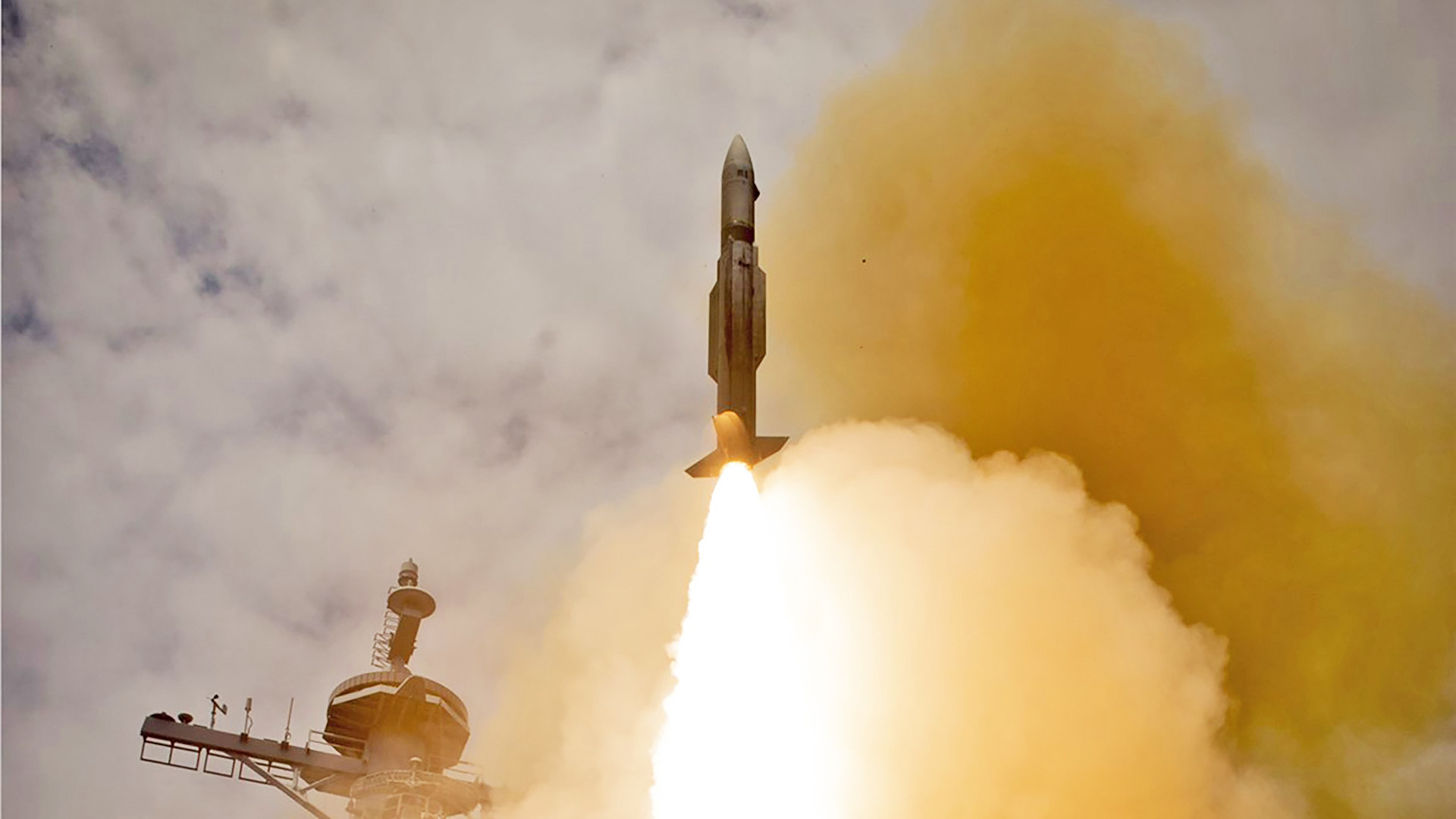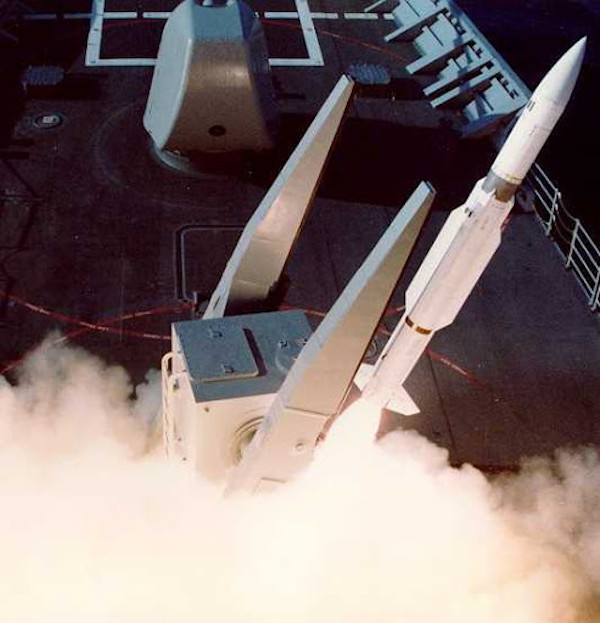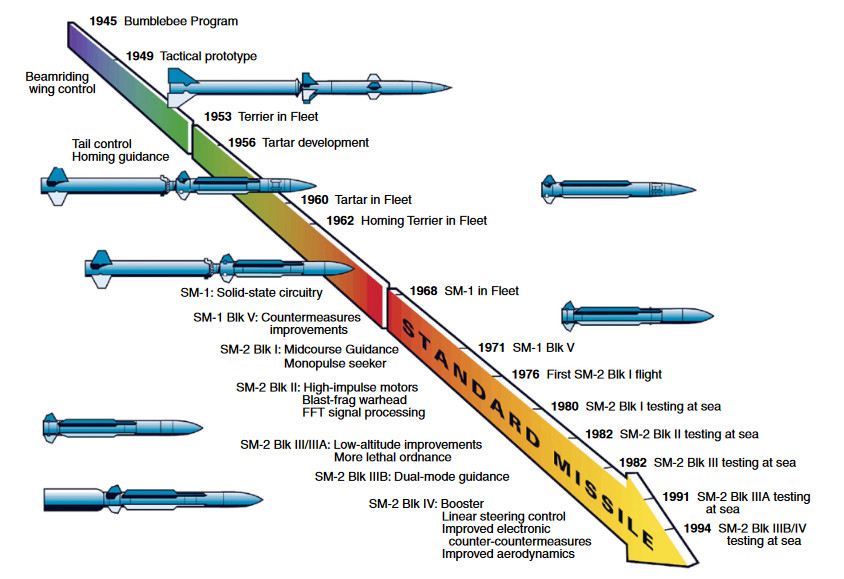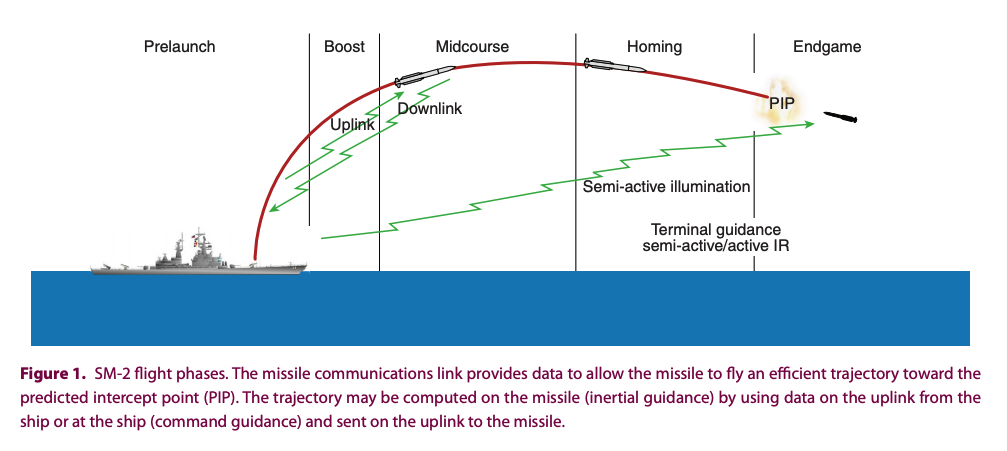Raytheon’s Standard Missile 6, or SM-6, has sucked up most of the public’s attention in recent years as it has become the most versatile surface-to-air and surface-to-surface weapon in the U.S. Navy’s arsenal. Other services are now taking notice, too, and the Navy is already working on building an even more capable version. Still, the older SM-2 branch of the Standard family of missiles, also sometimes referred to collectively in its newer form as the SM-2 Medium Range (SM-2MR), remains the backbone of the Navy’s area air defense capability. These missiles sit in hundreds of vertical launch cells and ships’ magazines around the globe, ready to defend U.S. and allied fleets against a range of aerial threats.
Although few know much about it, of the SM-2 variants that are in service now, as well as those that are planned for the future, the Block IIIB version is particularly notable. It has a dual-mode guidance package, with semi-active radar and infrared homing seekers installed on the same missile. The Block IIIB, which first entered service in 1998, was way ahead of its time and its capabilities will continue to remain very valuable in the coming years as potential adversaries, especially China and Russia, field increasingly advanced electronic warfare systems and other countermeasures, as well as low-observable (stealth) technologies.

At the core of the Block IIIB variant is the basic SM-2 Block III missile, production of which had started in 1988. At that time, the Block III represented the apex of the development of the medium-range Standard missile, or RIM-66, which had first begun in 1963 with the aim of replacing older RIM-2 Terrier and RIM-24 Tartar missiles.
The first medium-range Standard, also known as Standard Missile 1 Medium Range (SM-1MR), entered service in 1967. Between then and 1968, four blocks of the SM-1MR were developed, with relatively minor improvements. All of these were designated as subvariants of the RIM-66A. The Navy subsequently acquired a Block V SM-1MR, also designated the RIM-66B, which included much more substantial changes, including a new seeker, autopilot, warhead, and rocket motor. This combined to make the missile more accurate, harder-hitting, and capable of engaging targets at higher altitudes and further away.
The first missile in the SM-2MR series, which are also designated as variants of the RIM-66, was developed primarily to complement the then-new Aegis Combat System in the 1970s. The initial SM-2MR variant, the RIM-66C, was designed to be command-guided to the general target area by an Aegis-equipped ship via a data link and then use semi-active radar homing—where the ship ‘illuminates’ the target with its radar systems and missile’s seeker homes in on the reflected radar energy—in the terminal stage of flight. The SM-2 also had an upgraded semi-active radar homing seeker compared to earlier SM-1 variants.

The value of the improvements found on the SM-2MR meant that a subsequent version was developed for non-Aegis ships. This variant, known as the RIM-66D, would be preprogrammed right before launch to head to a designated target area using its inertial navigation system (INS) guidance package alone, before switching over to its semi-active radar seeker to actually find its mark.
Block II SM-2MR variants began arriving in 1983, featuring new warheads and rocket motors, the latter of which expanded their range out to around 90 miles, as well as their ability to engage more maneuverable targets. The Block II subvariants also included the first missile in the series to be designed to be fired from Mk 41 Vertical Launch System (VLS) cells, as well as one for non-VLS equipped ships. At around the same time, a final Block VI version of the SM-1MR, also appeared, subvariants of which progressively incorporated other improvements from the SM-2 series, including new seekers and warheads.

The Block III’s main improvement over the earlier SM-2s had been the addition of an upgraded radar proximity fuze. This improved the reliability with which the missile’s warhead detonated during intercepts, especially when engaging targets at low altitudes, such as anti-ship cruise missiles.
As with the Block IIs, the Block III missile came in three subvariants, the RIM-66K, RIM-66L, and RIM-66M. The RIM-66K was the version for non-Aegis ships, while the RIM-66L was the one for vessels with the Aegis Combat System. The RIM-66M was the Aegis-compatible type configured to be fired from the Mk 41 VLS.
In 1991, production then began of the further improved Block IIIA missile, which featured a more powerful blast-fragmentation warhead. Different versions of these weapons were also made that were compatible with the older deck-mounted arm launchers, as well as the newer Mk 41 VLS.
Then came the Block IIIB variant, the focus of this article, which combined the Block IIIA with a guidance package developed under the Missile Homing Improvement Program (MHIP). The complete MHIP guidance system is distinct from that on earlier SM-2s, though it still includes a semi-active radar seeker in the nose. In addition, it has an infrared seeker mounted inside a small streamlined fairing that juts out from the side of the missile’s forward body. You can see this arrangement in the photo at the top of this post.

The Navy had developed the MHIP guidance package in part for improved air and surface-launched versions of the Sparrow missile, which were designated AIM-7R and RIM-7R, respectively. The service canceled this improved Sparrow project in 1996 over rising costs. This was done despite the largely successful completion of an operational evaluation and in spite of a plan to save money by converting older Sparrow models to new R variant configuration.

In the end, the MHIP guidance system was only ever used on the Block IIIB variant of the SM-2. Unlike earlier SM-2s, this missile was designed to only be fired from the Mk 41 VLS.
As of 2017, all three Block III subvariants, as well as the extended-range SM-2 Block IV, also known as the RIM-156A, that also first entered service in 1998, were still in use, according to the Navy, providing its ships with a mixture of capabilities. It’s interesting to note that the Navy was also working on a dual-mode RIM-156B variant before canceling that project in 2001. That weapon had been intended to serve as an anti-ballistic missile interceptor. The focus subsequently shifted to the development of the SM-3 and SM-6 variants of the Standard missile for knocking down various types of ballistic missiles at different points of their flight.

The Block IIIB’s unique dual-mode guidance package makes it very capable against a wide array of targets in multiple engagement scenarios. The infrared seeker importantly provides an alternative means of finding the target in the terminal phase of flight even in heavy electronic warfare combat environments. Similarly, if the optics on the infrared part of the guidance system are degraded, blinded, or confused, it still has the semi-active radar homing option.
Most of all, the infrared seeker allows for these missiles to obtain lock when engaging targets flying at very low altitudes that are beyond the line-of-sight of the Mk 82 guided missile radar director’s AN/SPG-62 illuminators, three of which equip each Arleigh Burke class destroyer and four of which are on every Ticonderoga class cruiser. They are used to ‘paint’ or ‘illuminate’ the target during the missile’s endgame terminal phase of flight. This is not possible when engaging very low-flying targets at significant ranges due to the curvature of the earth.

Without the infrared component, the SM-2 Block IIIB’s radar seeker is dependent on homing in on reflected radar energy produced by the ship. With the addition of passive infrared homing, it does not have to rely on radar illumination of a target. So, even if the illuminator is in the shadow of the Earth’s curvature, the missile can still make the kill. It also helps when engaging small radar cross-section (stealthy) targets or those with advanced electronic warfare capabilities in any flight profile, as well. The IR seeker is impervious to these countermeasures.
To detail how these missiles work, the SM-2MR leverages data-link networking and inertial navigation to get itself out in an area where it can make its terminal attack run on the target, which can be dozens of miles. The Aegis SPY-1 radar data is sent to the missile—this information can now also come from a third-party asset, such as an E-2 Hawkeye flying overhead—as it flies out toward the target. Prior to its final run on the target, the ship illuminates the target, at which time the missile’s semi-active radar seeker would lock onto the reflected radar energy. In the case of the Block IIIB, the infrared sensor would also lock onto the target, making it extremely hard for the target to survive the missile’s attack. If the target cannot be illuminated, the infrared seeker can still prosecute the target on its own. In the end, the dual-mode seeker setup doesn’t just make certain engagements possible, it offers a better probability of kill overall.

The SM-2 Block IIIB’s guidance system makes it stand out from most Western medium-to-long-range surface-to-air missiles, as well as air-to-air weapons in similar classes, the vast majority of which use some kind of radar homing alone. The two newest Block III variants, the Block IIIAZ, developed solely for use on the Navy’s Zumwalt class stealth destroyers, and the still-in-development Block IIIC, have single-mode guidance systems. The Block IIIAZ is a modification of the Block IIIA design to work with the Zumwalt‘s unique radar and combat system configuration, which you can read more about in this past War Zone piece, while the Block IIIC is an upgrade of older Block III missiles that replacing the semi-active radar guidance system with the much more capable active-radar seeker from the SM-6.

Adding the active seeker will allow these missiles to engage targets without launch platform illumination and, much like the infrared seeker on the Block IIIB, allow them to engage low-flying targets below the radar horizon of the launching vessel. The latest active seekers are very capable and are hard to jam and decoy, but dual-mode seekers still offer some insurance when it comes to either seeker type failing or being confused for whatever reason during the terminal phase of an engagement. The best mix today would be both passive imaging infrared homing and active radar homing on the same missile.
America’s near-peer competitors, such as Russia and China, are well aware of all of this and have made substantial investments in aerial electronic warfare capabilities. Increasingly advanced self-protection jammers for aircraft, as well as other countermeasures systems, are proliferating more and more, even to smaller militaries, too. Cruise missiles themselves are increasingly built with countermeasure capabilities, including small radar cross-section (stealthy) characteristics and more.

The importance, then, of multi-mode guidance systems for surface-to-air and air-to-air missiles is becoming ever more apparent around the world, including within the U.S. military. It seems more likely than not, for instance, that the new AIM-260 long-range air-to-air missile that Lockheed Martin is developing now for the Navy, and, by extension the U.S. Marine Corps, as well as the U.S. Air Force, will have a multi-mode guidance package. Peregrine, a compact air-to-air missile that Raytheon unveiled in 2019, will also feature a “multi-mode autonomous seeker,” according to that company.
The most notable surface-to-air missile that is operational today with this dual-mode capability is Israel’s Stunner. It is the missile used by the David’s Sling air defense system that is currently a major component of Israel’s layered integrated air and missile defense system. It features an active radar and imaging infrared seeker in its unique ‘dolphin’ nosecone. This is widely considered as a ‘best of both worlds’ combination which is thought to make evasion, jamming, or decoying the missile largely impossible. It has been reported that Israel is now working on an air-to-air derivative of its Stunner surface-to-air missile. In many regards, the Stunner is the modern successor of the SM-2 Block IIIB concept. You can read all about the Stunner in this past feature of ours.

Multi-mode guidance systems are also becoming increasingly popular on air-to-ground and ground-launched munitions due to the flexibility they provide when engaging multiple types of targets under diverse conditions. This is especially true for moving targets that are targeted over the horizon.
With all this in mind, it’s no surprise then that the Navy expects to continue fielding the SM-2 Block IIIB through at least 2035, well after the new Block IIIC missiles are slated to start filling Mk 41 VLS cells on the service’s warships in 2022. The Block IIIB missiles are also set to stay in use for years to come even as other advanced surface-to-air missiles, such as variants of the SM-6, enter more widespread service.

One would imagine that the Navy would not want to give up its SM-2 Block IIIB until it can acquire a suitable replacement, which could also feature multi-mode guidance. The service does say that the Block IIIC missile offers “enhanced capability against electronic attack” since its active radar seeker doesn’t require a ship to illuminate the target with its own SPG-62 Illuminator during its terminal phase of flight. But as we mentioned earlier, it still doesn’t provide the same kind of jam-resistant alternative guidance option that an infrared seeker does.
It’s also worth noting that the SM-2 Block IIIBs represent a lower-cost-per-engagement option compared to the Block IIIC, despite the dual-mode guidance. They’re certainly cheaper than SM-6s, though those missiles are much more capable and are intended for a wider array of targets. The Navy bought its last Block IIIBs in the 2011 Fiscal Year, at which time the unit cost for each missile was approximately $1.138 million, or around $1.316 million in 2020 dollars. In its Fiscal Year 2021 Budget Request, the Navy said it expected to pay $2.349 million for each conversion kit to turn existing older Block III SM-2s into Block IIICs. The stated unit price of the SM-6 in those same documents was just over $4.318 million.
If Block IIIBs are still within this price range, it could make them attractive to foreign countries that field other SM-2 variants or otherwise have ships capable of firing them. In 2020, Raytheon notably restarted the SM-2 production line in order to meet existing demand for Block IIIBs, as well as Block IIIAs and Block IIICs, from various countries.
Australia, Japan, and South Korea are among the customers currently in process of acquiring new-build Block IIIB missiles. Spain also secured approval to buy these weapons in 2018. In addition, the Netherlands has Block IIIA missiles on order, while Taiwan and Chile have recently received approval to buy those missiles. Canada has been approved to buy Block IIICs, as well. This is of no surprise as the threat of ever more advanced anti-ship missiles is ballooning.
While it gets little attention, the U.S. Navy will also continue to make use of the SM-2 Block IIIB missiles, along with the ‘ahead of its time’ capabilities that they offer, for years to come.
Contact the author: joe@thedrive.com
